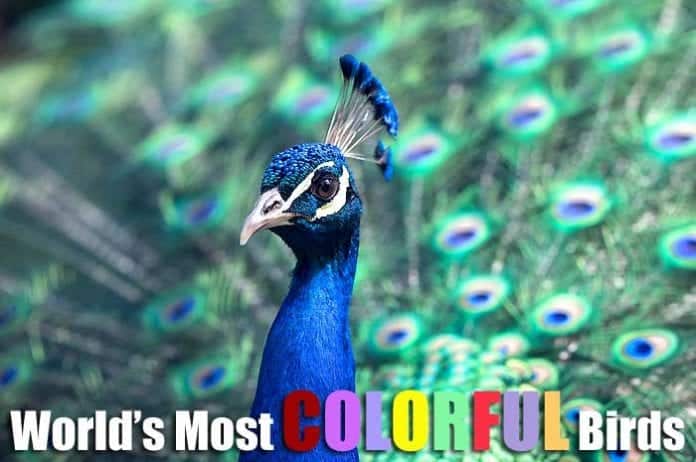
Colorful birds: Among terrestrial animals, birds are probably the most colorful[A] in terms of physical appearance. As expected, the spectacular display of various colors and patterns shown by different bird species is significant because birds themselves can recognize colors.
Table of Contents
- Characteristics of Colors in Birds
- Colorful Feathers
- List of Colorful Birds
- 1. Red-necked Tanager
- 2. Mandarin Duck
- 3. Blue Crowned Pigeon
- 4. Blue/Azure Kingfisher
- 5. Paradise Tanager
- 6. Andean Cock-of-the-Rock
- 7. Purple Gallinule
- 8. Yellow-collared Lovebird
- 9. Northern Cardinal
- 10. Curl-crested Aracari
- 11. Spangled Cotinga
- 12. Toco Toucan
- 13. Gouldian Finch
- 14. Red-bearded Bee Eater
- 15. Lilac-breasted Roller
- 16. Crimson Rosella
- 17. Splendid Fairy Wren
- 18. Crowned Woodnymph
- 19. Painted Bunting
- 20. Indian Peafowl
- 21. Scarlet Macaw
- 22. The Resplendent Quetzal
- 23. Rainbow Lorikeet
- 24. Golden Pheasant
- 25. Scarlet-chested Parakeet
- 26. Wilson’s Bird-of-Paradise
- 27. Cassin’s Finch
- 28. Crimson Rosella
- 29. Elegant Parrot
- 30. Plum-throated Cotinga
- 31. Golden-collared Toucanet
- 32. Hoatzin
- 33. Orange-breasted Green Pigeon
- 34. Lady Amherst’s Pheasant
- 35. Bornean Crested Fireback
- 36. Senegal Parrot
- Conclusion
Characteristics of Colors in Birds
Regarding physical appearance, most bird exhibit sexual dimorphism, a trait wherein males are highly distinguishable from females. Males seem more colorful and dazzling than females for one apparent reason: to attract females during mating.
Colorful Feathers
Collectively speaking, bird feathers are referred to as the plumage. In particular, the plumage color in birds is formed in two different processes:
A) On one hand, colorful feathers are brought about by various pigments produced by birds. Such pigments are melanin, carotenoid, and porphyrin. The pigment melanin produces colors ranging from pale yellow to reddish-brown to dark black. The pigment carotenoid produces colors ranging from bright yellow to orangish-yellow. For instance, the pigments melanin and carotenoid interaction produce an olive-green color. Lastly, the pigment porphyrin produces various colors, such as brown, bright red, pink, and green.
B) On the other hand, bird feather colors are produced by the feathers’ structure. This means that instead of the pigments, colors are made when the feathers’ proteins refract the light. Three structural feathers exist, namely:
- Iridescent Feathers: Iridescent feathers can change their color at different viewing angles.
- Non-iridescent Feathers: Non-iridescent feathers can change from blue to brown depending on the light conditions.
- Ultraviolet Feathers: Ultraviolet feathers can reflect light found within the ultraviolet range.
Henceforth, listed below are the 36 most beautiful birds of the world in the Class Aves (birds) of the Animal Kingdom with Phylum as Chordata.
You can see the IUCN red list categories[B] for each of these colorful birds listed below, which represents the vulnerability of the species at present. This ranges from Extinct to Least Concern.
List of Colorful Birds
Here we go! Welcome to the colorful birds world!
1. Red-necked Tanager

| Passeriformes | Thraupidae | Tangara | Tangara cyanocephala |
 Endemic[1] to Eastern South America, the red-necked tanager appears to be very bright with its yellow-orange wings, bright red chin, deep blue crown and lower neck, and a brilliant green underneath.
Endemic[1] to Eastern South America, the red-necked tanager appears to be very bright with its yellow-orange wings, bright red chin, deep blue crown and lower neck, and a brilliant green underneath.
- These colorful birds are known to reside in the canopy of forests and are characterized by their sharp “sip” sounding voices.
- Generally, the red-necked Tanager molts (sheds its feathers) once a year.
2. Mandarin Duck
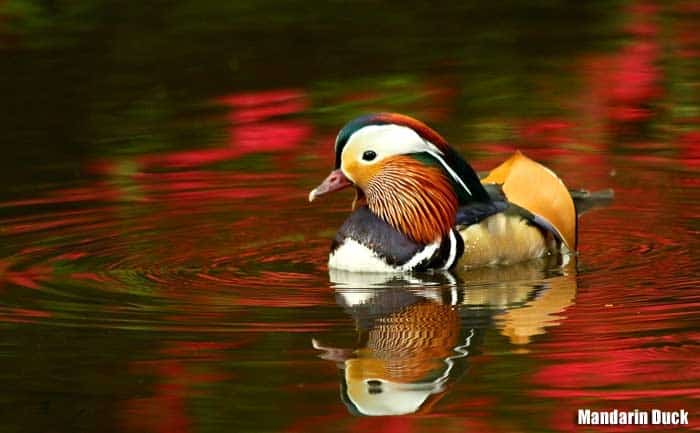
| Anseriformes | Anatidae | Aix | Aix galericulata |
 Regarded as the world’s most beautiful duck[2], this native from China (hence the name) and Japan, this duck displays a wide array of colors such as blue, green, copper and silver.
Regarded as the world’s most beautiful duck[2], this native from China (hence the name) and Japan, this duck displays a wide array of colors such as blue, green, copper and silver.
- While both genders of the duck have a crest, this structure is more prominent in males, probably because this is mainly used to attract during mating.
- Also, males appear golden.
3. Blue Crowned Pigeon
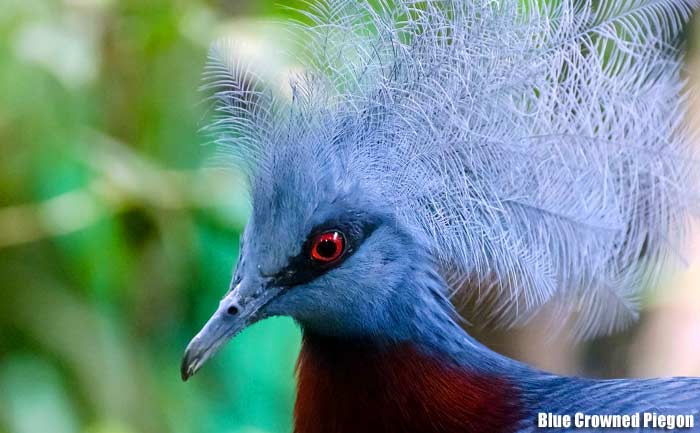
| Columbiformes | Columbidae | Goura | Goura cristata |
 Also known as the Western crowned pigeon[3], the blue-crowned pigeon is characterized by having large blue crests in the head, and deep blue feathers around the eyes.
Also known as the Western crowned pigeon[3], the blue-crowned pigeon is characterized by having large blue crests in the head, and deep blue feathers around the eyes.
- Western crowned pigeons are very large pigeons and considered one of the “fairest” members of the Family Columbidae (Pigeons).
- Generally, like most birds in the animal kingdom, male blue-crowned pigeons are larger than their female counterparts.
- These colorful birds are native to Papua New Guinea and tend to be dispersed in the island’s rainforests.
The Blue-crowned Pigeon is considered among the rare birds, as it is classified as Vulnerable by the IUCN due to habitat loss and hunting pressures.
4. Blue/Azure Kingfisher
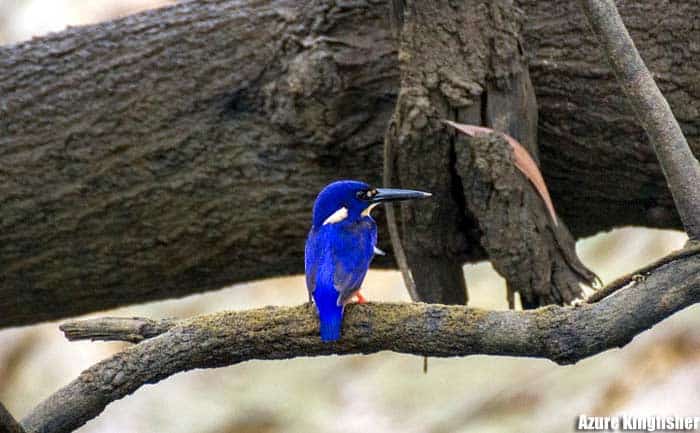
| Coraciiformes | Alcedinidae | Ceyx | Ceyx azureus |
 Known to be great fish hunters[4] from the riverside and sometimes above the water surface, blue kingfishers are small to medium size birds which have a very colorful appearance.
Known to be great fish hunters[4] from the riverside and sometimes above the water surface, blue kingfishers are small to medium size birds which have a very colorful appearance.
- The feathers of kingfishers are mostly bright blue/azure (hence the name) in color.
- Unlike most birds, the feather color of kingfishers is caused by the feathers’ structure. Such causes the scattering of blue light, which is then reflected in our eyes, making them appear blue.
- The distribution pattern of kingfishers is cosmopolitan. Meaning they occur throughout the world, even in either temperate or tropical regions.
5. Paradise Tanager
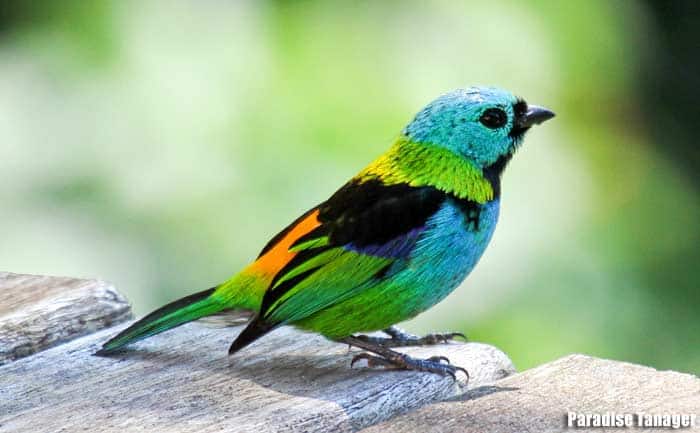
| Passeriformes | Thraupidae | Tangara | Tangara chilensis |
 Classy, neotropical, and colorful[5], the Paradise Tanager is living up to its name. This bird, widely distributed in the tropical forests of the Amazon in South America, is small yet very colorful with its bright apple green head, yellow or red rump (depending on species), and blue abdomen.
Classy, neotropical, and colorful[5], the Paradise Tanager is living up to its name. This bird, widely distributed in the tropical forests of the Amazon in South America, is small yet very colorful with its bright apple green head, yellow or red rump (depending on species), and blue abdomen.
- Aside from its appearance, the paradise tanager is a songbird, meaning it can make various musical sounds that are pleasant to the ears.
- One disclaimer though: this bird is not found in Chile, despite its species name T. chilensis.
6. Andean Cock-of-the-Rock
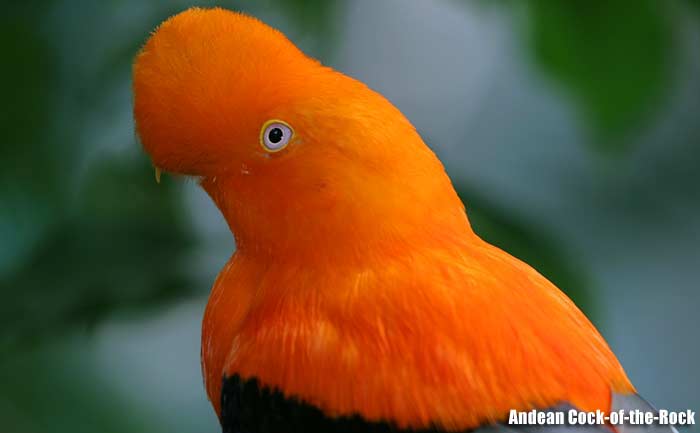
| Passeriformes | Cotingidae | Rupicola | Rupicola peruvianus |
 Considered the national bird of Peru[6], this small to medium-sized bird made it to the list of most colorful birds.
Considered the national bird of Peru[6], this small to medium-sized bird made it to the list of most colorful birds.
- Male Andean Cock-of-the-Rock birds are more colorful with their bright red head, breast, throat, and shoulders. They have grey wings, black underparts, and prominent disk crests over their bill.
- Conversely, the female birds are orange to brown and have smaller crests.
- This bird is usually found in warm regions, riverbanks, and forest streams.
7. Purple Gallinule
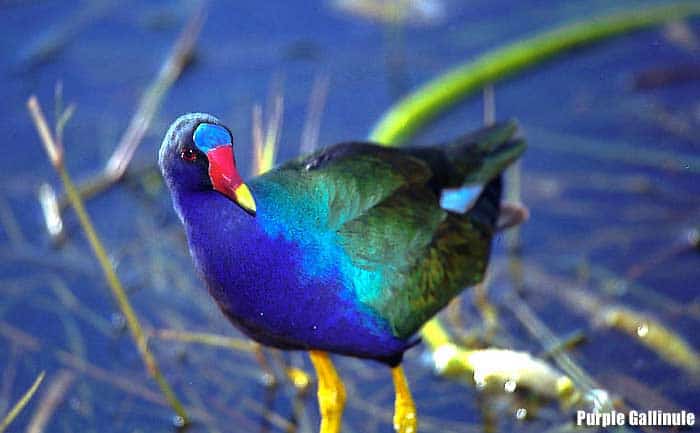
| Gruiformes | Rallidae | Porphyrio | Porphyrio martinicus |
 The Purple Gallinule[7] is considered as one of the most beautiful birds primarily because of its plumage that displays a variety of colors.
The Purple Gallinule[7] is considered as one of the most beautiful birds primarily because of its plumage that displays a variety of colors.
- Overall, this bird has a purple head, throat, and underparts, a greenback, a blue forehead, and a red beak with a yellow tip.
- Added to this uniqueness are its yellow legs.
- Interestingly, these colorful birds swim like ducks but can step on floating leaves like chickens.
- Basically, this species of bird is widely distributed in the humid and tropical regions of the United States.
8. Yellow-collared Lovebird
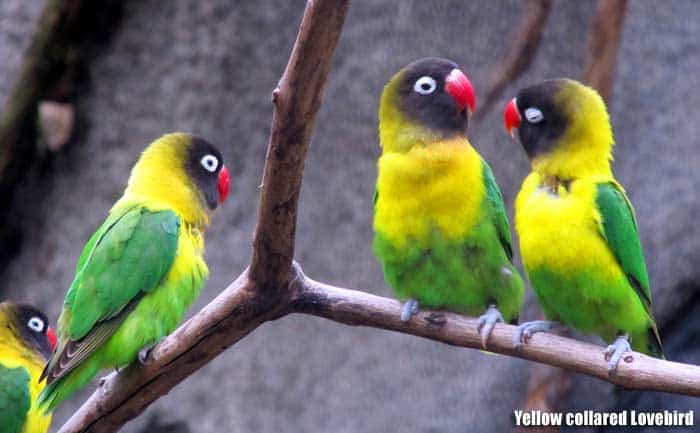
| Psittaciformes | Psittaculidae | Agapornis | Agapornis personatus |
 Also known as Masked lovebirds, yellow collared lovebirds[8] are small colorful birds which are generally green in appearance (although upper parts are darker). In addition to that, they have black-colored heads and white eyerings, and very bright red beaks.
Also known as Masked lovebirds, yellow collared lovebirds[8] are small colorful birds which are generally green in appearance (although upper parts are darker). In addition to that, they have black-colored heads and white eyerings, and very bright red beaks.
- As their name suggests, they have a yellow collar extending to the nape of the neck.
- Interestingly enough, the males and females of this species look identical in appearance.
- These colorful birds are endemic to Tanzania but were already brought to other countries like Kenya and Burundi.
9. Northern Cardinal
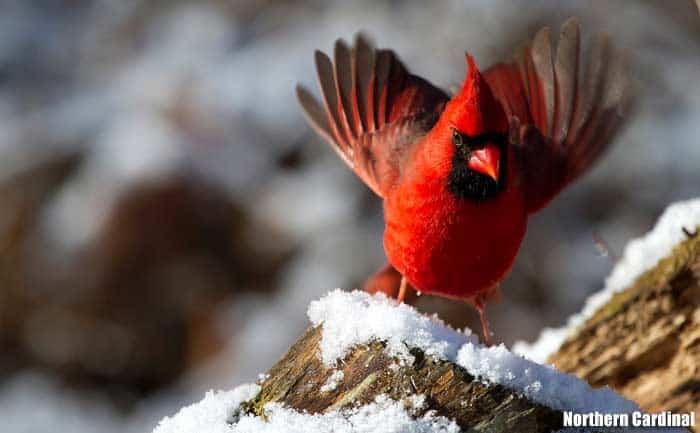
| Passeriformes | Cardinalidae | Cardinalis | Cardinalis cardinalis |
 Endemic to both North and South America, the Northern Cardinal bird[9] is a songbird characterized by striking red and black face mask which extends up to the upper chest.
Endemic to both North and South America, the Northern Cardinal bird[9] is a songbird characterized by striking red and black face mask which extends up to the upper chest.
- Females of this bird type are shown to be brown to grayish with some tints of red in their wings.
- Male Northern Cardinals have more defined face masks.
- At an early age, the colors of both males and females are identical to the adult females. But when fall comes, they shed their old feathers and grow new ones.
- The name of this bird (both scientific and common name) comes from the “cardinals” of the Roman Catholic Church, who usually wear red caps and robes.
The Northern Cardinal is a vibrant and cherished species among Florida birds, easily recognized by the male’s striking red plumage and the female’s subtle fawn tones.
What Do Cardinals Eat?
10. Curl-crested Aracari
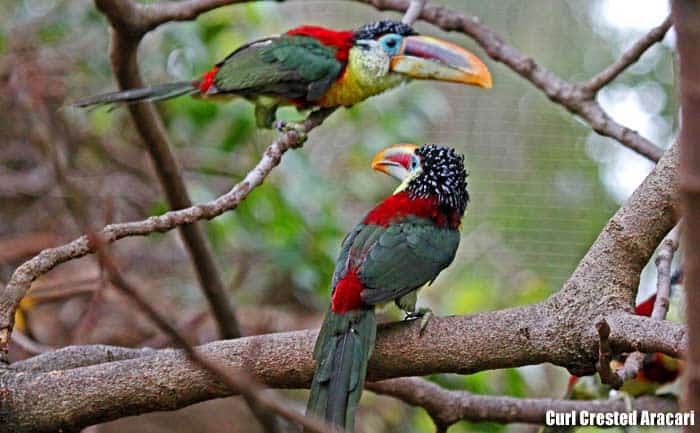
| Piciformes | Ramphastidae | Pteroglossus | Pteroglossus beauharnaesii |
 Coming from the Family Ramphastidae (Toucans), this bird is considered as one of the most colorful yet strangest looking bird[10] in the world. This bird is characterized by having yellow underparts, a red back, dark green wings, and a very colorful beak.
Coming from the Family Ramphastidae (Toucans), this bird is considered as one of the most colorful yet strangest looking bird[10] in the world. This bird is characterized by having yellow underparts, a red back, dark green wings, and a very colorful beak.
- This bird has unusual head feathers that can be likened to shiny black plastics.
- This bird is endemic only to the lowland forests of Western Brazil, Northern Bolivia, and Southern Amazon.
11. Spangled Cotinga
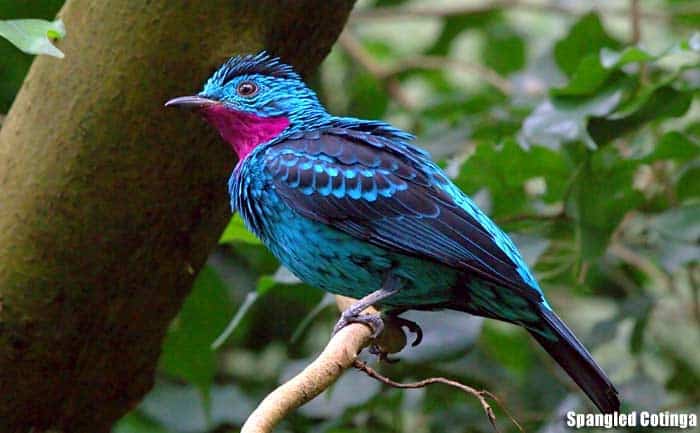
| Passeriformes | Cotingidae | Cotinga | Cotinga cayana |
 The Spangled Cotinga is a type of bird that frequently resides in the canopy of the Amazonian forests.
The Spangled Cotinga is a type of bird that frequently resides in the canopy of the Amazonian forests.
- Like any other bird species, male Spangled Cotingas[11] are very brightly colored–they are turquoise in appearance with tints black in their back and wings, and a bright purple neck.
- Conversely, females are duller in color with an overall brown to grayish body and a prominent purple throat.
- Interestingly, the Spangled Cotinga bird lacks true vocalization. It can only emit a “whistling” sound as it flaps its wings when flying.
12. Toco Toucan
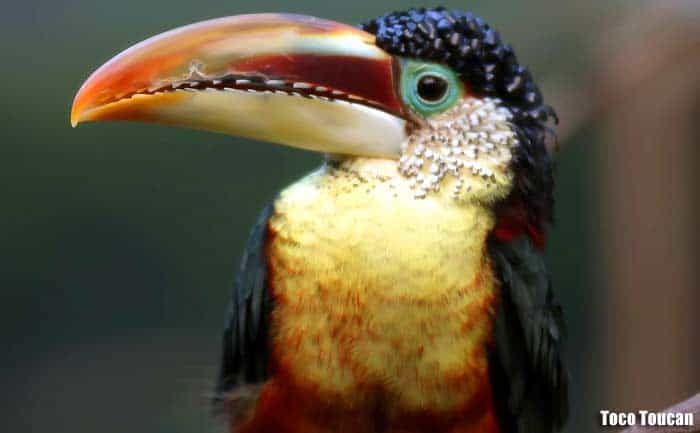
| Piciformes | Ramphastidae | Ramphastos | Ramphastos toco |
 Characterized by its very prominent multicolored beak[12], the Toco Toucan is the largest among all toucans. Aside from that, it is very recognizable due to its extremely black body, white throat, and blue eye rings.
Characterized by its very prominent multicolored beak[12], the Toco Toucan is the largest among all toucans. Aside from that, it is very recognizable due to its extremely black body, white throat, and blue eye rings.
- Aside from its physical appearance, the toucan bird makes an amazing creature because it can somehow regulate its overall body temperature by altering the blood flow in its beak.
- The Toco Toucan is endemic to South America and inhabits the savannas, tropical forests, and shrubland.
13. Gouldian Finch
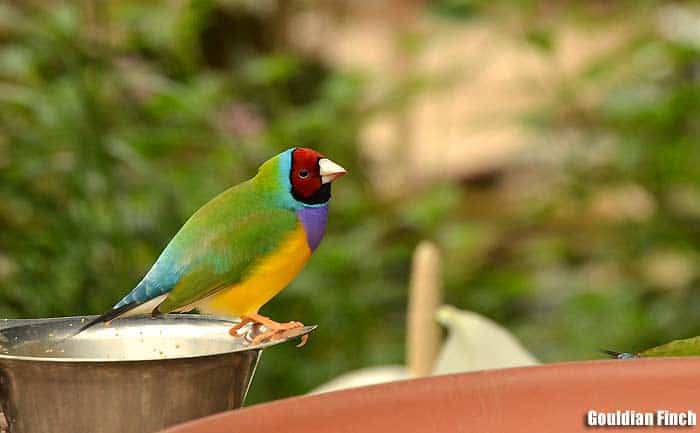
| Passeriformes | Estrilididae | Erythrura | Erythrura gouldidae |
 Also known as the Rainbow finch, the Gouldian Finch is typically found in the savanna woodlands of Northern and Western Australia.
Also known as the Rainbow finch, the Gouldian Finch is typically found in the savanna woodlands of Northern and Western Australia.
- Like any bird, the male Gouldian Finch is extremely recognizable[13] from its female counterpart. Males appear more brightly colored and have more intricate color marks and patterns.
- Both genders have green, black, yellow, and red markings. However, the males’ chests are purple, while the females are lilac.
14. Red-bearded Bee Eater
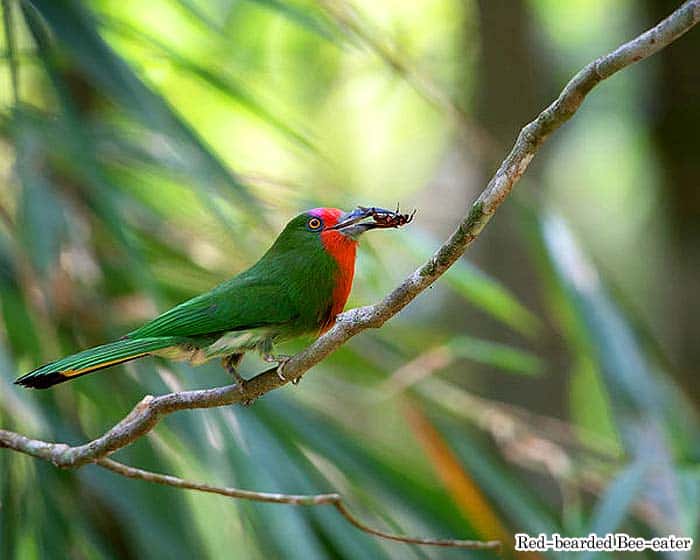
| Coraciiformes | Meropidae | Nyctyornis | Nyctyornis amictus |
 As its name suggests, the Red Bearded Bee Eater is a bee-eater type of bird that resides in the dense forests of the Indo-Malayan regions of South East Asia[14].
As its name suggests, the Red Bearded Bee Eater is a bee-eater type of bird that resides in the dense forests of the Indo-Malayan regions of South East Asia[14].
- This bird has an overall green color and a prominent red color in its face up to its throat (hence its name).
- In addition to that, they are characterized by having long tail feathers and curved brakes, and very pointed wings.
15. Lilac-breasted Roller
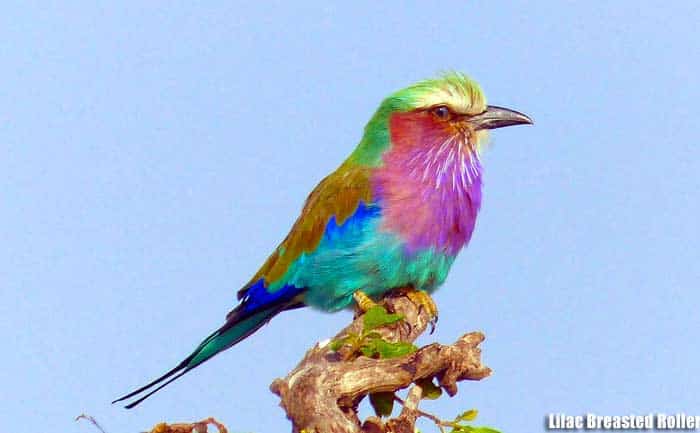
| Coraciiformes | Coraciidae | Coracias | Coracias caudatus |
 A member of the bird Family Coraciidae (Rollers), the Lilac-breasted Rollers are widely distributed in the Eastern and Southern Africa.
A member of the bird Family Coraciidae (Rollers), the Lilac-breasted Rollers are widely distributed in the Eastern and Southern Africa.
- Generally, this bird has a rich lilac color for its breast, pale green head, violet wings (shoulders, flight feathers, and rump), pale greenish blue coverts, blue underparts, brown back and scapulars, and black tail feathers.
- The lilac-breasted roller, like any other roller, is famous for its courtship flight[15].
16. Crimson Rosella
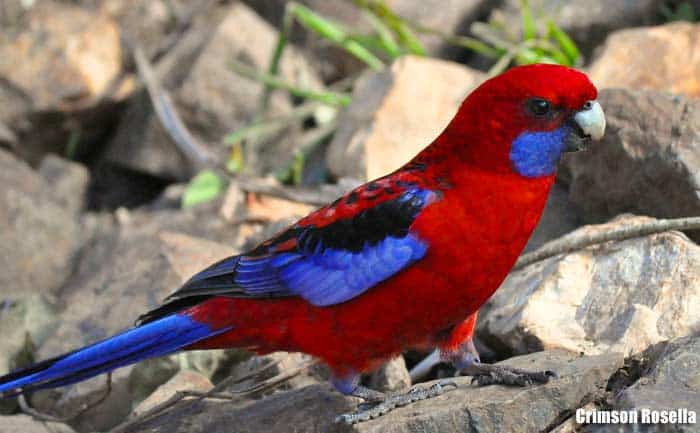
| Psittaciformes | Psittaculidae | Platycercus | Platycercus elegans |
 As its name suggests, the Crimson Rosella[16] is highly characterized by its crimson body. Apart from that, the back and wing feathers are black but with some tints of red. Its flight feathers have alternate pale to dark blue patches.
As its name suggests, the Crimson Rosella[16] is highly characterized by its crimson body. Apart from that, the back and wing feathers are black but with some tints of red. Its flight feathers have alternate pale to dark blue patches.
- Most Crimson Rosella reside in the wet forests of Northern Queensland and South Australia.
17. Splendid Fairy Wren
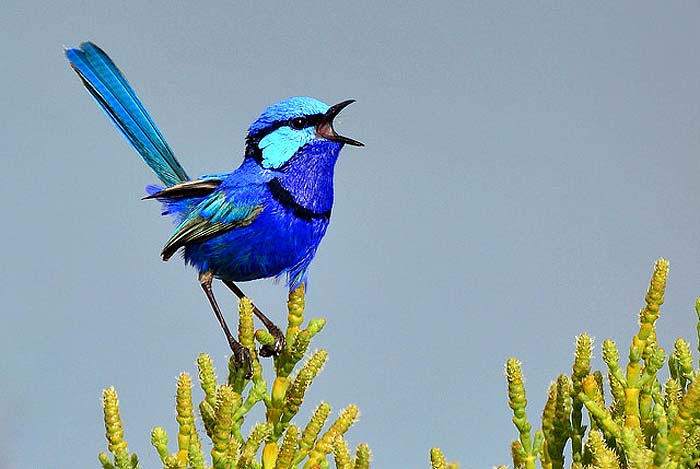
| Passeriformes | Maluridae | Malurus | Malurus splendens |
 The Splendid Fairy Wren is known to inhabit in the semi-arid to arid woodlands and shrublands of Australia[17].
The Splendid Fairy Wren is known to inhabit in the semi-arid to arid woodlands and shrublands of Australia[17].
- The feathers of the male Fairy-wren are dominantly blue (cobalt blue to violet-blue) in color. Its beak and legs are black and brown to gray, respectively.
- Conversely, the female Fairy-wren is paler with an overall brown color and white underparts. However, females have a distinguishable reddish tan line that extends from the beak up to the eyes.
18. Crowned Woodnymph
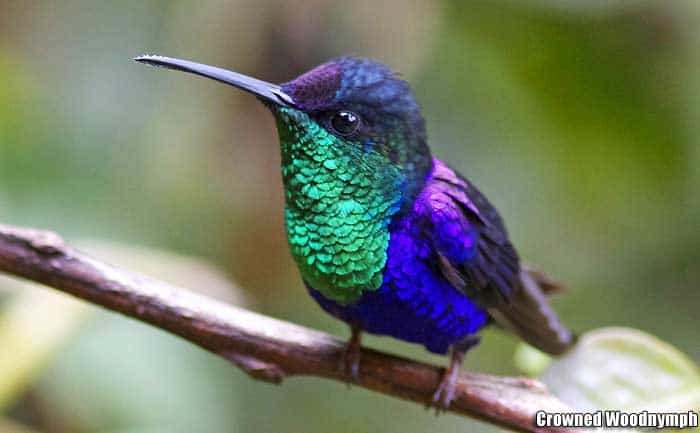
| Apodiformes | Trochilidae | Thalurania | Thalurania colombica |
 The Crowned wood nymphs are members of the genus Thalurania which is composed of hummingbirds. These types of hummingbirds generally reside in Eastern Panama up to Southern Ecuador[18].
The Crowned wood nymphs are members of the genus Thalurania which is composed of hummingbirds. These types of hummingbirds generally reside in Eastern Panama up to Southern Ecuador[18].
- As its name suggests, the violet-crowned woodnymph is the only one with a glittering green crown.
- Male Crowned Wood Nymphs are characterized by having green necks and blue breasts and abdomen.
- On the other hand, the female type of this bird is paler in color with a gray colored neck and a dark green to gray abdomen.
19. Painted Bunting
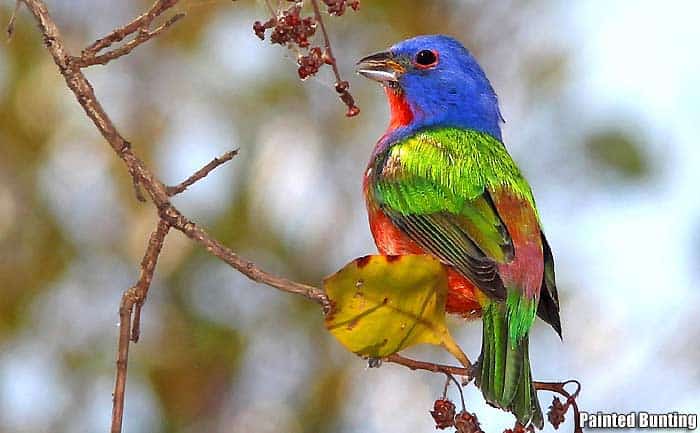
| Passeriformes | Cardinalidae | Passerina | Passerina ciris |
 The Painted Bunting bird is a member of the bird family Cardinalidae which is endemic to North America[19].
The Painted Bunting bird is a member of the bird family Cardinalidae which is endemic to North America[19].
- The male Painted Bunting has the French name, nonpareil, which means “without equal”, thus referring to its extremely fascinating appearance. The male plumage displays various colors, such as blue and green. Red and yellow.
- The female type of this bird is distinguishable due to its very prominent bright green color.
20. Indian Peafowl
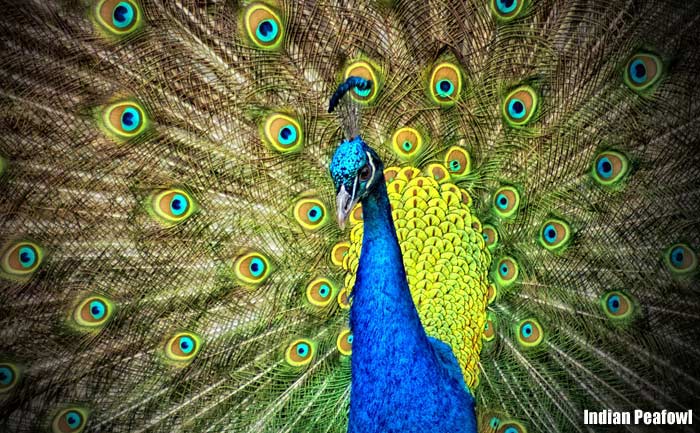
| Galliformes | Phasianidae | Pavo | Pavo cristatus |
 As its name implies, the Indian peafowl can be found in India, Sri Lanka, in other countries of South Asia[20].
As its name implies, the Indian peafowl can be found in India, Sri Lanka, in other countries of South Asia[20].
- The Indian Peafowl is a member of the group called pheasants wherein the males are referred to as the peacocks whereas females are peahens. Collectively, they are called the peafowls.
- Like any other birds that display a sexually dimorphic trait, peacocks have a dazzling fan (up to 5 feet) of feathers of brilliant colors that grow from their back. Aside from that, males have a somewhat head crest and green throat feathers. As peacock feathers’ brilliant, shimmering patterns are iconic, some cultures treat them as sacred artifacts for prosperity.
- The vividly colored male peacock woos the female by spreading a spectacular fan of iridescent feathers with big glowing eyes. If the female is sufficiently impressed, she may allow him to mate.
- Conversely, peahens are duller in color, with only an overall brown body and white abdomen.
21. Scarlet Macaw
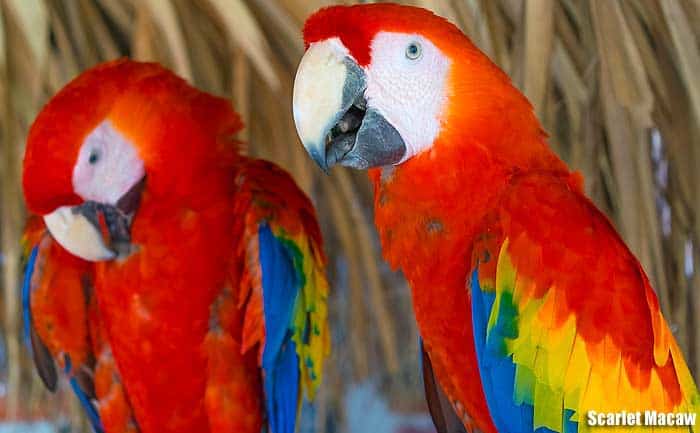
| Psittaciformes | Psittacidae | Ara | Ara macao |
 Macaws are considered as the largest species of colorful parrots in the world. For instance, scarlet macaws are widely distributed in the rainforests of Mexico, and Central and Southern America[21].
Macaws are considered as the largest species of colorful parrots in the world. For instance, scarlet macaws are widely distributed in the rainforests of Mexico, and Central and Southern America[21].
- Generally, the scarlet macaw, besides its overall red color, displays a wide mix of green, yellow, and blue feathers.
- Besides that, macaws are considered one of the most intelligent birds as they spend a lot of time using various tools and playing with objects.
22. The Resplendent Quetzal
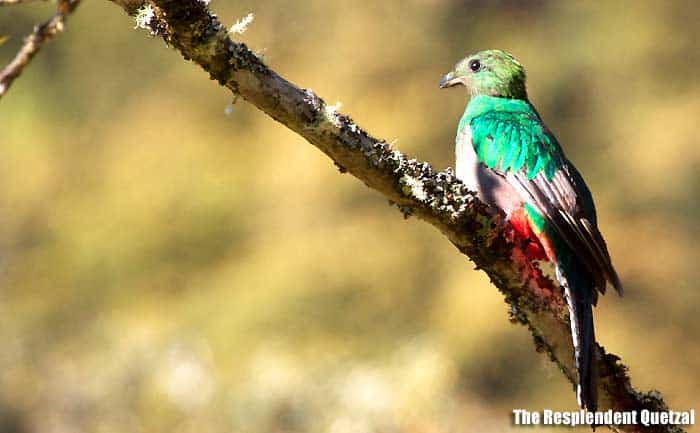
| Trogoniformes | Trogonidae | Pharomachrus | Pharomachrus mocinno |
 A member of the Trojan bird family, this bird resides in the mountainous regions of Central America[22].
A member of the Trojan bird family, this bird resides in the mountainous regions of Central America[22].
- Interestingly enough, the iridescent color of this bird changes from green to blue depending on the time of the day.
- The Quetzal is known to inhabit the mountainous and tropical forests of Central America.
23. Rainbow Lorikeet
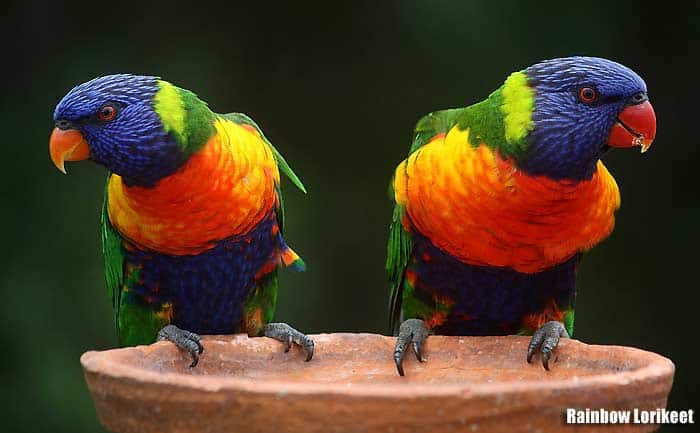
 Often seen in flocks, this bird is very distinguishable due to its feathers that range from green, blue, orange, and yellow[23].
Often seen in flocks, this bird is very distinguishable due to its feathers that range from green, blue, orange, and yellow[23].
- Aside from that, its most striking feature is its beak, which is bright red.
- Both sexes of this bird are identical in physical appearance.
- A lorikeet’s tongue has a brush-like tip for gathering nectar, fruits, and insects.
- Lorikeets are communal birds – they gather in the evening to spend the night.
- Basically, Rainbow Lorikeets are distributed in the coastal regions of Northern and Eastern Australia.
24. Golden Pheasant

| Psittacifornmes | Psittaculidae | Trichoglossus | Trichoglossus moluccanus |
 Also known as the Chinese Pheasant, the Golden Pheasant is a very timid bird that usually resides in the dark forests at day and only comes out during the night[24].
Also known as the Chinese Pheasant, the Golden Pheasant is a very timid bird that usually resides in the dark forests at day and only comes out during the night[24].
- Exhibiting sexually dimorphic traits, the male Golden Pheasants are distinguishable because of their golden crest. Aside from that, it has a bright red abdomen, dark-colored wings, and a long patterned brown tail.
- On the other hand, the female Golden Pheasant is less colorful in appearance, with an overall brown body and pale yellow legs. The female bird is also thinner and more slender.
- As its name suggests, the Golden Pheasant can be found in the forests of central and western parts of China.
25. Scarlet-chested Parakeet
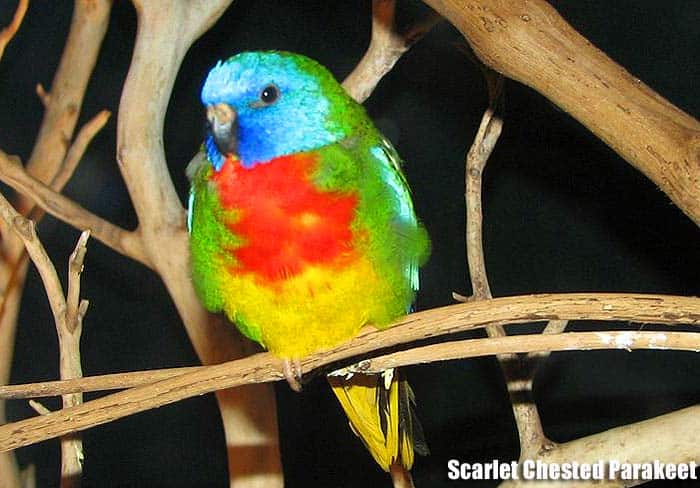
| Psittaciformes | Psittaculidae | Neophema | Neophema splendida |
 Our next colorful bird is the beautiful Scarlet-chested parrot (aka scarlet-breasted parrot). These colorful birds are endemic to Southern Central Australia and some Southern Western Australia.
Our next colorful bird is the beautiful Scarlet-chested parrot (aka scarlet-breasted parrot). These colorful birds are endemic to Southern Central Australia and some Southern Western Australia.
- Appearance-wise, these birds have two forms (i.e., sexually dimorphic). The bright blue-faced with a scarlet chest and yellowish lower part among the green plumage is the male, whereas the female is almost the same except missing the red color in the chest.
- Diet-wise, these colorful birds feed on grass seeds. These parakeets can last long without water as they eat succulent plants that help them keep hydrated.
- The binomial name for the scarlet-chested parrot is Neophema splendida, which was named by the famous ornithologist John Gould in 1841.
- The Breeding season for these parrots is from August to October.
26. Wilson’s Bird-of-Paradise
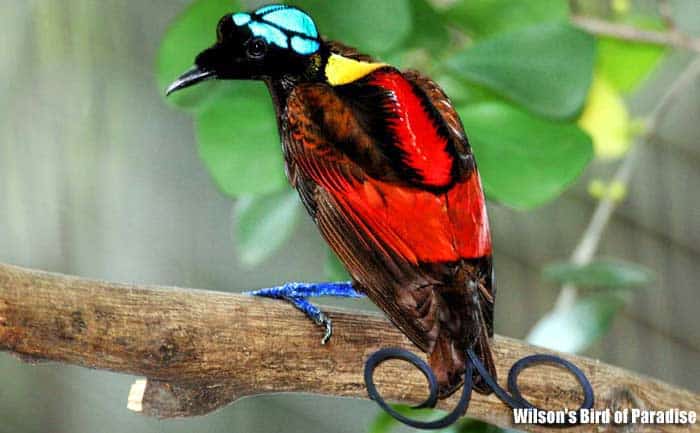
| Passeriformes | Paradisaeidae | Cicinnurus | Cicinnurus respublica |
 Last but not the least is the Bird-of-Paradise, which is not to be confused with the Birds of Paradise plant. Most Bird-of-Paradise birds are distributed in Papua New Guinea, Australia, and Eastern Indonesia[25].
Last but not the least is the Bird-of-Paradise, which is not to be confused with the Birds of Paradise plant. Most Bird-of-Paradise birds are distributed in Papua New Guinea, Australia, and Eastern Indonesia[25].
- The male type of this bird is shown to exhibit a wide variety of colors: a prominent turquoise crown, yellow cape, red back, and green breast and tail feathers.
- Interestingly, though, the crowns of the males are not feathers but bare skin. Criss-crossed by black lines of feathers.
- Females are duller in appearance with a lilac-blue head, reddish upper body, and brown wings. Also, females lack tail feathers.
27. Cassin’s Finch
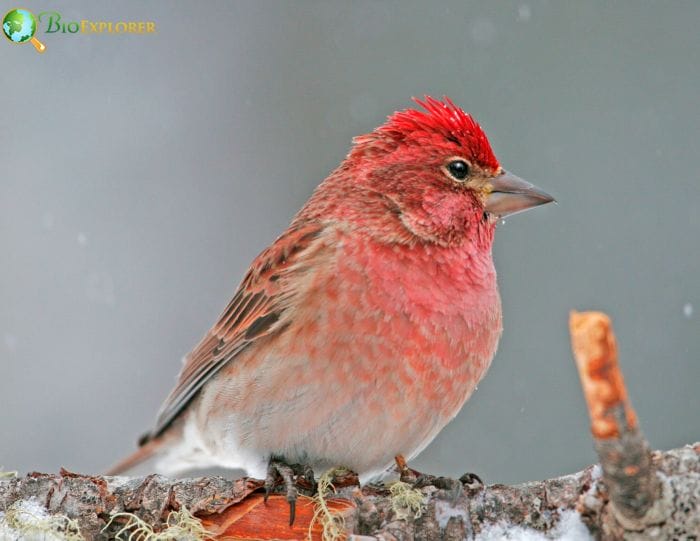
| Animalia | Aves | Passeriformes | Fringillidae | Chordata | Haemorhous cassinii |
 The Cassin’s Finch stands out as one of the most vividly colored finches inhabiting the coniferous forests of western North America.
The Cassin’s Finch stands out as one of the most vividly colored finches inhabiting the coniferous forests of western North America.
- Adult male Cassin’s Finches display uniquely bright plumage, with rosy pink bodies that contrast sharply against dull brown streaking on their flanks and breast. Their crowns and rumps are colored a rich reddish-orange, unlike any other finch in their range.
- When perched among pine branches, the males’ brightly hued bodies appear to glow against the green needles. Their boldly peaked heads and sharply etched wing patterns add to the Cassin’s visual allure.
- Females are more demure, yet still elegant, with delicately streaked gray-brown plumage that provides camouflage while nesting. Though small, the Cassin’s Finch punches above its weight with a remarkable intensity of color and artful plumage well-adapted to life amidst western mountain habitats.
The Cassin’s vivid aesthetic stands out both in the field and in contrast to their more modestly dressed finch relatives.
28. Crimson Rosella
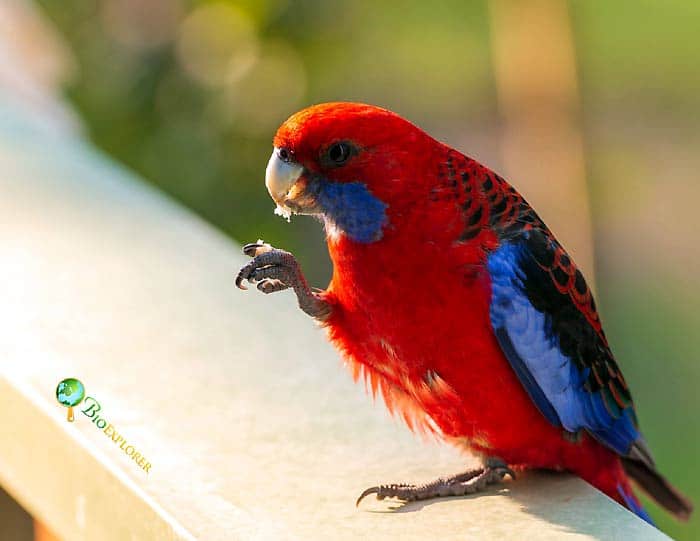
| Animalia | Aves | Psittaciformes | Psittacidae | Chordata | Platycercus elegans |
 The crimson rosella (Platycercus elegans) is a brilliantly colored parrot native to eastern and southeastern Australia. It measures around 36 cm (14 inches) in length. Adults exhibit a vivid crimson body with blue cheeks and black-scalloped blue wings, while the tail feathers are predominantly blue with some red markings on the central feathers. Juveniles start with a greenish-olive color that transitions to the crimson of adults as they mature.
The crimson rosella (Platycercus elegans) is a brilliantly colored parrot native to eastern and southeastern Australia. It measures around 36 cm (14 inches) in length. Adults exhibit a vivid crimson body with blue cheeks and black-scalloped blue wings, while the tail feathers are predominantly blue with some red markings on the central feathers. Juveniles start with a greenish-olive color that transitions to the crimson of adults as they mature.
- Crimson rosellas inhabit coastal and mountain forests, from sea level to the tree line, and have adapted well to human-modified environments such as gardens and parks.
- They primarily feed on fruit, seeds, nectar, berries, and nuts, occasionally consuming insects and larvae. Their diet and foraging behavior make them integral to their ecosystems, aiding in seed dispersal and plant pollination.
- The crimson rosella’s adaptability and striking plumage make it a favorite among bird watchers and pet owners alike.
29. Elegant Parrot
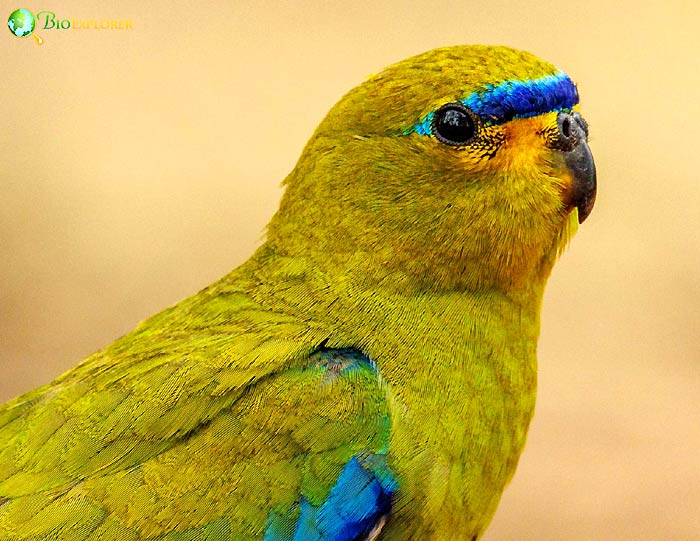
| Animalia | Aves | Psittaciformes | Psittacidae | Chordata | Neophema elegans |
 The elegant parrot (Neophema elegans) is a small, colorful bird native to Australia, particularly in southwestern and southeastern regions. It measures around 23 cm (9.1 inches) long and is known for its striking golden olive plumage. The forehead and wings are dark blue, while the abdomen and vent are bright yellow. The tail is a mix of olive and blue, and the bill and legs are grey.
The elegant parrot (Neophema elegans) is a small, colorful bird native to Australia, particularly in southwestern and southeastern regions. It measures around 23 cm (9.1 inches) long and is known for its striking golden olive plumage. The forehead and wings are dark blue, while the abdomen and vent are bright yellow. The tail is a mix of olive and blue, and the bill and legs are grey.
- These pretty parrots prefer habitats such as coastal heaths, open woodlands, and grasslands. They primarily feed on seeds, fruits, flowers, and leaves. Their diet and adaptability make them well-suited to various environments, including human-altered landscapes.
- The elegant parrot breeds in tree hollows, laying about 4-6 eggs per clutch.
- This multi-color bird is a favorite among bird enthusiasts due to its beautiful coloration and active, social behavior.
30. Plum-throated Cotinga
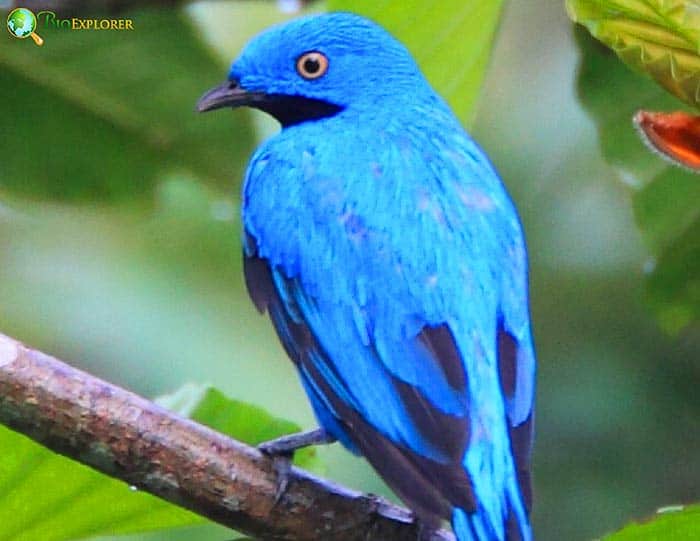
| Animalia | Aves | Passeriformes | Cotingidae | Chordata | Cotinga maynana |
 The plum-throated cotinga (Cotinga maynana) is a striking bird native to the tropical forests of Bolivia, Brazil, Colombia, Ecuador, and Peru. The male is particularly notable for its vivid and colorful plumage. It boasts an electric blue body that catches the eye from a distance. The throat is a deep, rich plum color, creating a stunning contrast with the blue feathers. The wings and back are also a vibrant blue, adding to the bird’s overall dazzling appearance.
The plum-throated cotinga (Cotinga maynana) is a striking bird native to the tropical forests of Bolivia, Brazil, Colombia, Ecuador, and Peru. The male is particularly notable for its vivid and colorful plumage. It boasts an electric blue body that catches the eye from a distance. The throat is a deep, rich plum color, creating a stunning contrast with the blue feathers. The wings and back are also a vibrant blue, adding to the bird’s overall dazzling appearance.
- In contrast, the female plum-throated cotinga is more subdued, with greenish tones that help her blend into the forest canopy. While less vivid than the males, the females still possess a certain understated beauty with their subtle hues.
- These birds are typically found in subtropical or tropical moist lowland forests and swamps, where their striking colors can be seen darting among the trees. The cotinga’s bright plumage plays a role in courtship displays, where males use their vivid colors to attract females.
- The diet of the plum-throated cotinga consists primarily of fruit, which they forage high in the canopy. This diet not only sustains them but also aids in seed dispersal, contributing to the health and regeneration of their forest habitats.
- The combination of its vibrant colors and important ecological role makes the plum-throated cotinga a fascinating and vital part of the tropical ecosystem.
31. Golden-collared Toucanet
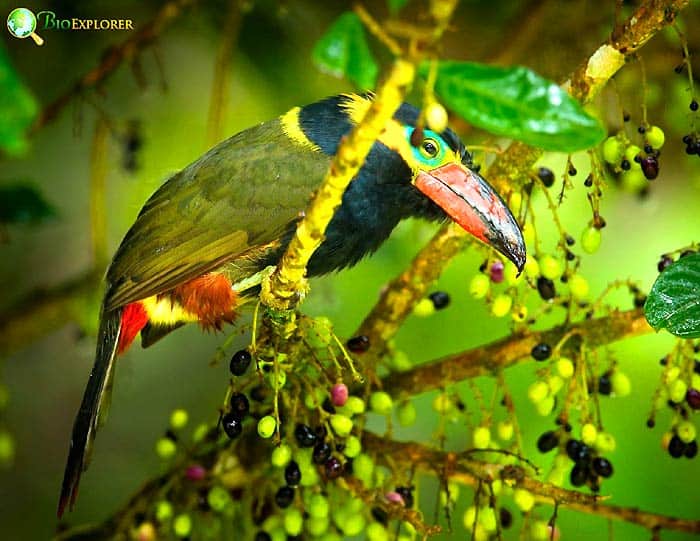
| Animalia | Aves | Piciformes | Ramphastidae | Chordata | Selenidera reinwardtii |
 The golden-collared toucanet (Selenidera reinwardtii) is a visually striking bird renowned for its vibrant and contrasting plumage. The male features a primarily black body adorned with a bright yellow collar that encircles its neck, giving the bird its name. The rump is a vivid red, while the tail is black. One of the most eye-catching features is its bill, which showcases a mix of yellow, green, and blue, adding to its colorful appearance. Females share a similar pattern but with more subdued tones and less vibrant coloring.
The golden-collared toucanet (Selenidera reinwardtii) is a visually striking bird renowned for its vibrant and contrasting plumage. The male features a primarily black body adorned with a bright yellow collar that encircles its neck, giving the bird its name. The rump is a vivid red, while the tail is black. One of the most eye-catching features is its bill, which showcases a mix of yellow, green, and blue, adding to its colorful appearance. Females share a similar pattern but with more subdued tones and less vibrant coloring.
- This toucanet inhabits humid lowland forests, thriving in the dense, tropical environments of Brazil, Colombia, Ecuador, and Peru. It is often found in the mid to upper canopy, where it can blend into the foliage despite its bright colors.
- The diet of the golden-collared toucanet is primarily frugivorous, consisting largely of various fruits. However, it also supplements its diet with insects and small vertebrates, playing a crucial role in seed dispersal within its ecosystem.
- The golden-collared toucanet is currently listed as “Least Concern” by the IUCN. This status indicates a stable population, though the species faces threats from habitat loss and deforestation.
32. Hoatzin
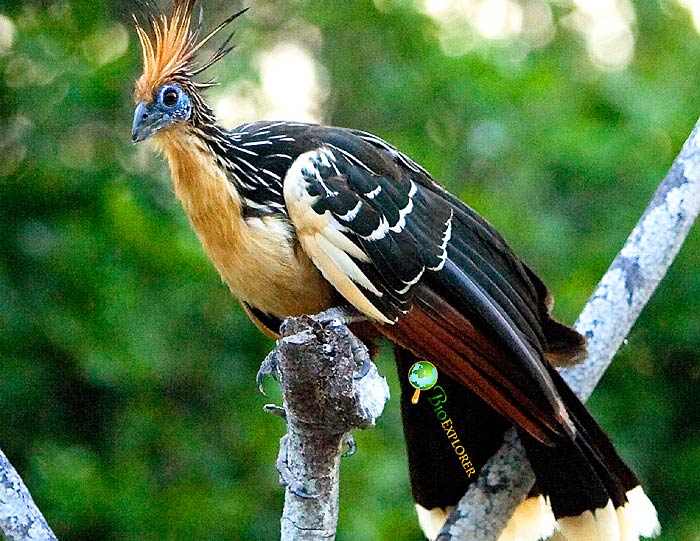
| Animalia | Aves | Opisthocomiformes | Opisthocomidae | Chordata | Opisthocomus hoazin |
 The hoatzin (Opisthocomus hoazin) is a unique and colorful bird found in the swamps, riparian forests, and mangroves of the Amazon and Orinoco basins in South America. Measuring about 65 cm (26 inches) in length, the hoatzin has a distinctive appearance with a long neck, small head, and a spiky rufous crest. Its unfeathered blue face contrasts with its maroon eyes, while the upper parts are dark, sooty brown with buff streaks, and the underparts are buff. The wings and flanks display rich rufous-chestnut hues, visible when the bird opens its wings. The tail is bronze-green tipped with a whitish or buff band.
The hoatzin (Opisthocomus hoazin) is a unique and colorful bird found in the swamps, riparian forests, and mangroves of the Amazon and Orinoco basins in South America. Measuring about 65 cm (26 inches) in length, the hoatzin has a distinctive appearance with a long neck, small head, and a spiky rufous crest. Its unfeathered blue face contrasts with its maroon eyes, while the upper parts are dark, sooty brown with buff streaks, and the underparts are buff. The wings and flanks display rich rufous-chestnut hues, visible when the bird opens its wings. The tail is bronze-green tipped with a whitish or buff band.
- The hoatzin inhabits tropical and subtropical swamps, riverine forests, and mangroves. It thrives in environments with dense vegetation near water sources.
- Among digestive system fun facts, the Hoatzin stands out as the only bird that uses foregut fermentation to digest leaves, a process similar to that of ruminant types of mammals like cows.
- The hoatzin is notable for its chicks, which have wing claws that help them climb branches. This bird is also the national bird of Guyana and is known locally as the Canje pheasant. Its distinct odor and taste usually deter hunting, except in times of extreme need.
While the Hoatzin is not classified among flightless birds, its unique digestive anatomy significantly limits its flight capabilities, resulting in short, laborious flights.
33. Orange-breasted Green Pigeon
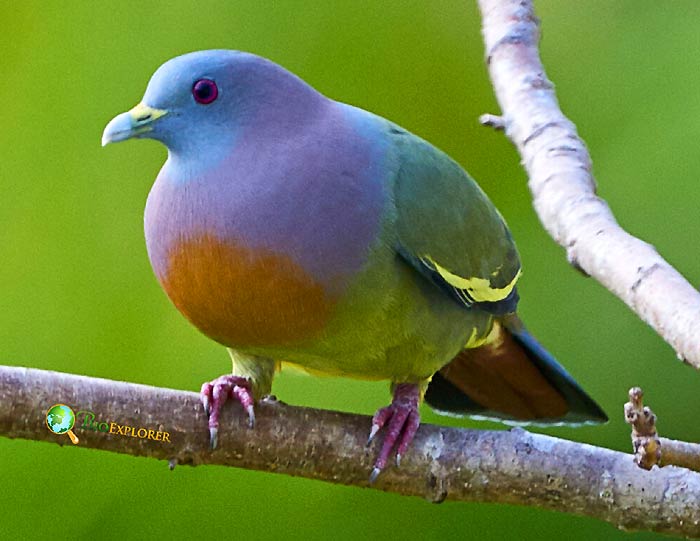
| Animalia | Aves | Columbiformes | Columbidae | Chordata | Treron bicinctus |
 The orange-breasted green pigeon (Treron bicinctus) is a colorful bird found across tropical Asia, including India, Sri Lanka, and Southeast Asia. Males are distinguished by their lilac and orange breast bands, contrasting with their green body, while females have a bright yellow breast and subtler undertail coverts. These pigeons inhabit forests and wooded areas, feeding mainly on small fruits and seeds.
The orange-breasted green pigeon (Treron bicinctus) is a colorful bird found across tropical Asia, including India, Sri Lanka, and Southeast Asia. Males are distinguished by their lilac and orange breast bands, contrasting with their green body, while females have a bright yellow breast and subtler undertail coverts. These pigeons inhabit forests and wooded areas, feeding mainly on small fruits and seeds.
- The orange-breasted green pigeon prefers dense forests, woodlands, and areas rich in fruit-bearing trees. They are often seen in the lower Himalayas and throughout Southeast Asia, including Bangladesh, Bhutan, Cambodia, India, Indonesia, Laos, Malaysia, Myanmar, Nepal, Sri Lanka, Thailand, and Vietnam.
- Their diet consists primarily of small fruits, especially figs, and seeds. They play a vital role in their ecosystem as seed dispersers, contributing to forest regeneration.
- These pigeons are known for their fast, direct flight and can often be seen in small flocks. Their call is a soft, modulated whistle. They breed from March to September in India and from December to May in Sri Lanka, nesting in trees where they lay one or two eggs.
34. Lady Amherst’s Pheasant
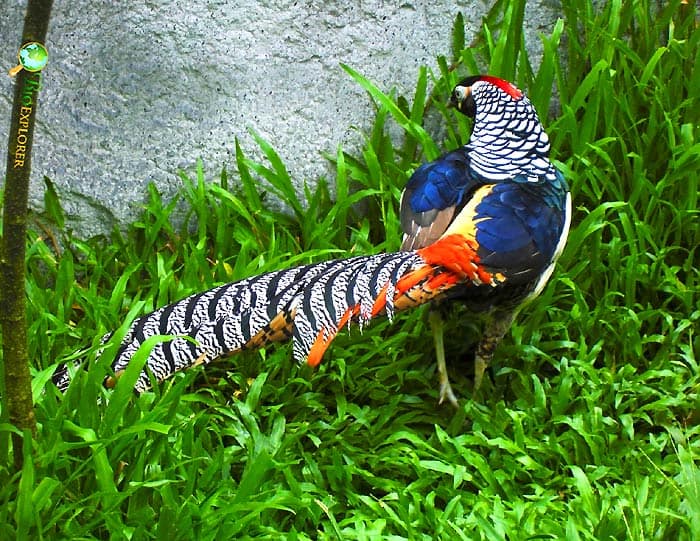
| Animalia | Aves | Galliformes | Phasianidae | Chordata | Chrysolophus amherstiae |
 Lady Amherst’s pheasant (Chrysolophus amherstiae) is a visually striking bird native to southwestern China and northern Myanmar. The adult male is particularly notable for its stunning appearance. It measures 100 to 120 cm in length, with the tail accounting for 80 cm of this total. The male features a white and black nuchal cape, a red crest, and a long greyish-white tail with black bars and red streaks. The chest and belly are white, the throat is scaled green, the back is dark green, the wings are blue and brown, and the rump is yellow.
Lady Amherst’s pheasant (Chrysolophus amherstiae) is a visually striking bird native to southwestern China and northern Myanmar. The adult male is particularly notable for its stunning appearance. It measures 100 to 120 cm in length, with the tail accounting for 80 cm of this total. The male features a white and black nuchal cape, a red crest, and a long greyish-white tail with black bars and red streaks. The chest and belly are white, the throat is scaled green, the back is dark green, the wings are blue and brown, and the rump is yellow.
- This pheasant inhabits dense, dark forests with thick undergrowth, making it difficult to spot in the wild. It has been introduced to other areas, including England, where it was once established but is now believed to be extinct in the wild.
- Lady Amherst’s pheasant primarily feeds on the ground, consuming a diet of grains, leaves, and invertebrates. They roost in trees at night and prefer to run rather than fly, though they can burst into flight with a distinctive wing sound when startled.
- The species is named after Sarah Amherst, who sent the first specimen to London in 1828.
- The male emits a metallic call during the breeding season.
- Despite its showy appearance, the bird is very elusive in its natural habitat.
35. Bornean Crested Fireback
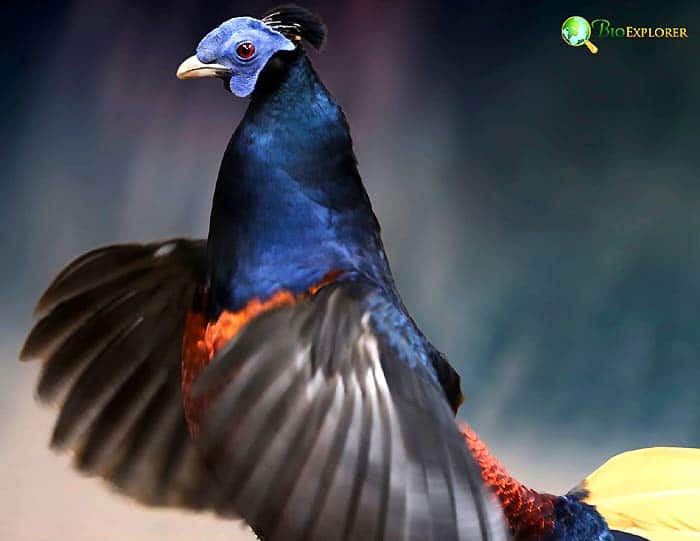
| Animalia | Aves | Galliformes | Phasianidae | Chordata | Lophura ignita |
 The Bornean crested fireback (Lophura ignita) is an exceptionally colorful bird, particularly the male. The male showcases a dazzling array of colors with its dark, iridescent bluish-black plumage, contrasted by a brilliant reddish-brown rump and distinctive black outer tail feathers. Its head is adorned with a peacock-like dark crest, and it has striking bare blue facial skin that highlights its red iris. In contrast, the female, while more subdued, displays a warm brown plumage with a short crest and blue facial skin, complemented by black-and-white spotted underparts.
The Bornean crested fireback (Lophura ignita) is an exceptionally colorful bird, particularly the male. The male showcases a dazzling array of colors with its dark, iridescent bluish-black plumage, contrasted by a brilliant reddish-brown rump and distinctive black outer tail feathers. Its head is adorned with a peacock-like dark crest, and it has striking bare blue facial skin that highlights its red iris. In contrast, the female, while more subdued, displays a warm brown plumage with a short crest and blue facial skin, complemented by black-and-white spotted underparts.
- This endangered colored bird inhabits the dense tropical forests of Borneo and the Bangka Belitung Islands, favoring areas with thick undergrowth for foraging and nesting.
- The Bornean crested fireback feeds on a mix of plant material, such as fruits, seeds, and leaves, and also includes small animals like insects in its diet.
- There are two recognized subspecies: L. i. ignita and L. i. nobilis, with minor differences in tail and leg colors.
36. Senegal Parrot
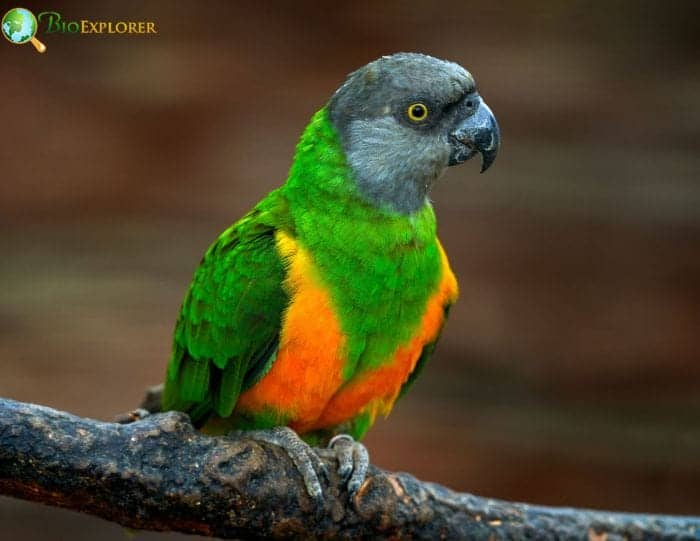
| Animalia | Aves | Psittaciformes | Psittacidae | Poicephalus | Poicephalus senegalus |
 The Senegal parrot (Poicephalus senegalus) is a vibrant African bird renowned for its striking plumage and engaging personality.
The Senegal parrot (Poicephalus senegalus) is a vibrant African bird renowned for its striking plumage and engaging personality.
- Measuring approximately 23 cm (9 inches) in length, these parrots exhibit a unique color pattern: a charcoal gray head, bright green back and wings, and a yellow or orange belly forming a distinctive V-shape on the chest.
- Native to the woodlands and savannas of West Africa, including countries like Senegal, Ghana, and Ivory Coast, they thrive in open habitats.
- In captivity, Senegal parrots are cherished as affectionate pets, known for their playful demeanor and ability to mimic sounds, although they are generally quieter than other parrot species.
- These African birds‘ beaks function as a third limb, aiding in climbing. Additionally, they can exhibit handedness, favoring either their left or right foot when handling objects.
Conclusion
While these colorful birds are spectacular, some of them are becoming endangered even in their native habitats. Due to their colorful and unique plumage, they have become a target for many hunters in the forest. Another major threat to these birds is the loss of habitats due to the deforestation and the environment in general.


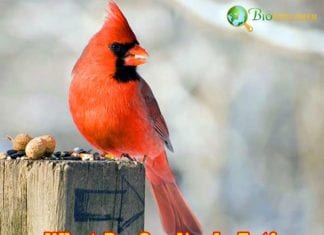

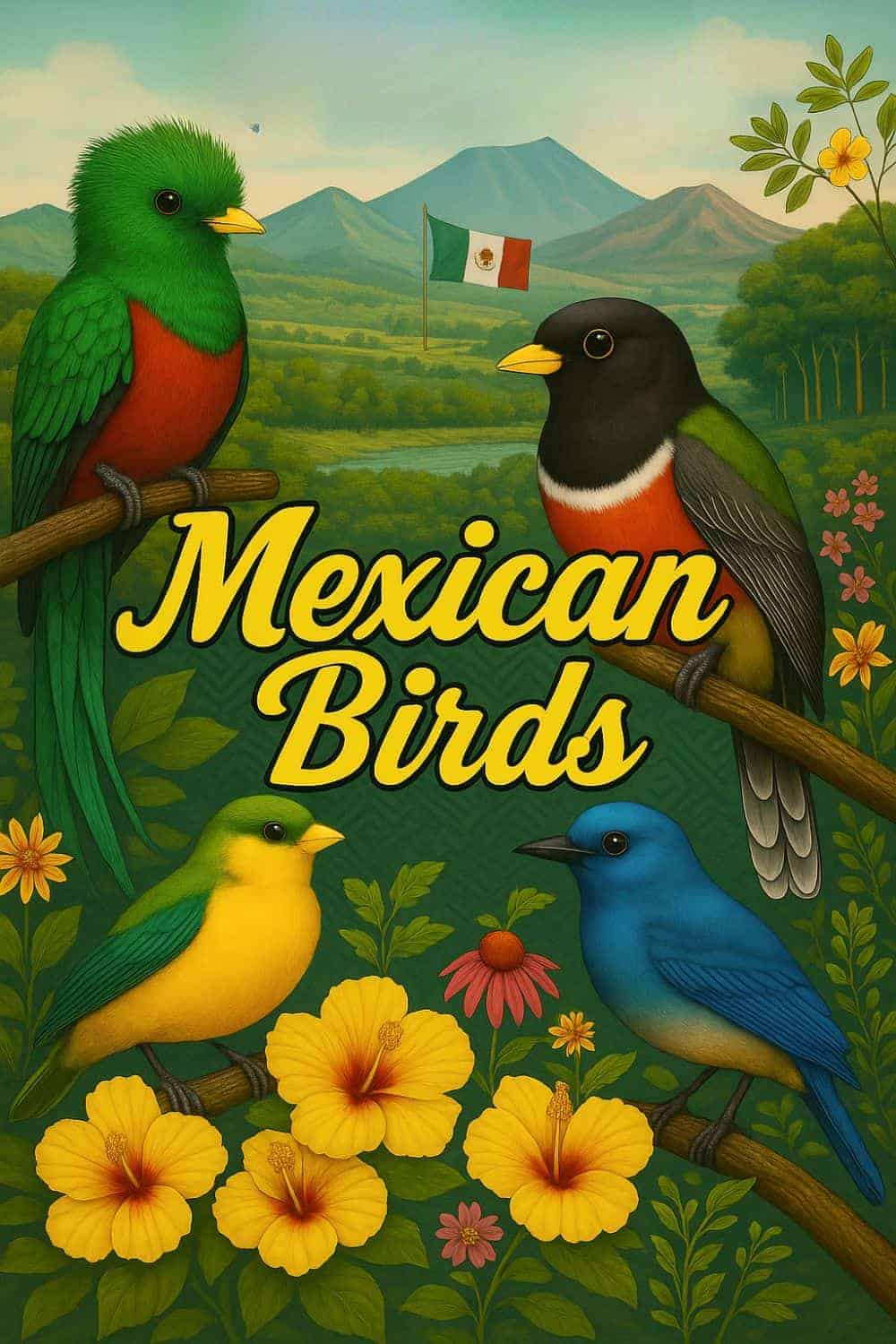
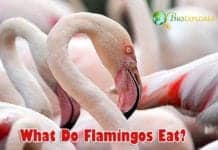
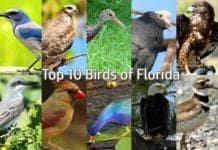
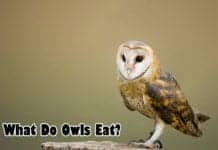
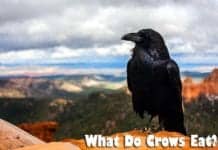










Really awesome article! Amazing birds.
You use Golden Peasant and Pheasant interchangeably. Not sure if that was purposeful 🙂
Hi the bird named Splendid Fairywren is infact a Superb Fairywren
The Splendid fairywren has much more blue than the Splendid Fairywren
The Splendid fairy wren is the Malurus splendens but the Splendid Fairywren (the one shown) is the Malurus cyaneus
Both are truly beautiful birds and deserve to be in the list
Not trying to be picky just correct
Regards
Martin
Thanks Martin. I fixed the picture for Splendid Fairywren!
very beautiful birds
Even looking at these photographs will simply make our mouth agape with awe. To appreciate their beauty we need not be a avid bird watcher. Yes, there are some ideal places in the world to watch those most beautiful bird that are dripping with colors and feathers. For further read: http://viewtraveling.com/where-to-watch-the-5-most-beautiful-bird-in-the-world/
The photo of the Red-Bearded Bee-Eater appears to be incorrect. It obviously doesn’t have a red beard. The photo looks like a European Bee-Eater. Also, in your bibliography, the link you have to your source at Animal Files shows a totally different bird – with a red beard. http://www.theanimalfiles.com/birds/kingfishers_relatives/red_bearded_bee_eater.html
Perhaps a correction of either the photo or the description would be in order. I didn’t check the other birds for accuracy but assuming this is the only error it is a beautiful, informative webpage.
Thanks, Donovan for taking the time to review this page. Just corrected the image.
A bird left out is the gorgeous Scarlet Chested Parakeet from Australia.
I agree Thomas. I will add it to this list.
Woooww i really enjoyed the article, its so amazing . It reminds me the time i went to Kruger National Park . I was surprised to hear that there are about 10 000 different species of birds. Its so cool. You can check Kruger National Park out guys http://www.krugerpark.co.za/. The trip advisers where so helpful as well, they seemed so knowledgeable, you can check out Iconic Africa trip advisers as well http://www.krugerpark.co.za/